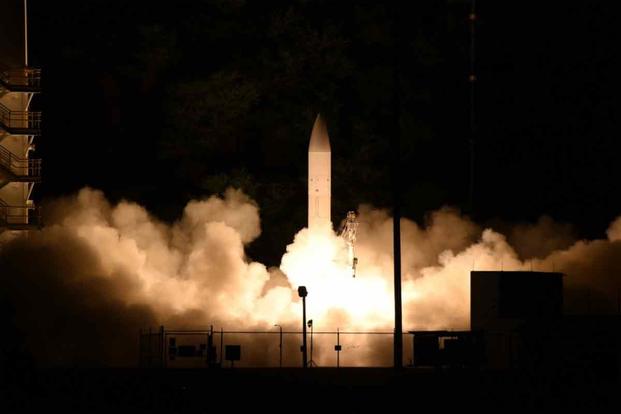The lieutenant general overseeing the Army's hypersonic weapons program said the service will soon accelerate testing of the ultra-fast missile effort to compete with Russia and China in the race to field the deadly new technology.
In a joint effort with the Navy, the Army has been designing the Common-Hypersonic Glide Body, which will be used by all U.S. services, and is preparing to transition it to the defense industry, which will mass produce the technology.
The Army will soon begin ramping up the testing schedule so it can field the first operational hypersonic missile battery by fiscal 2023, Lt. Gen. Neil Thurgood, director of Hypersonics, Directed Energy, Space, and Rapid Acquisition, said Wednesday during a Defense News space and missile defense webinar.
Read Next: Air Force OKs Pants for Women's Mess Dress Uniforms
"The flight test program is very aggressive, and we need to be aggressive in order to keep on case and be competitive with our near-peer competitors, namely Russia and China," he said.
Following a successful test in March, "we will actually accelerate our program; our next flight test will be mid-year of 2021, followed very quickly by two shots later in 2021," Thurgood said, adding that, until now, tests had been completed every three years.
The Pentagon's hypersonics effort is under real pressure to create a new class of ultrafast, maneuverable, long-range missiles capable of flying at five times the speed of sound. The Defense Department made hypersonic technologies a priority, nearly doubling its long-term investment, with almost $5 billion more in fiscal 2020 funding for hypersonics development alone in the next five years.
The increased funding follows advancements made by adversaries such as Russia, which claims to have unveiled a hypersonic glide vehicle capable of traveling more than 20 times the speed of sound.
Over the next 12 to 14 months, the Army will transfer the high-priority glide-body work from government laboratories to Dynetics Technical Solutions, the firm selected last August to produce the first commercially manufactured set of prototype Common-Hypersonic Glide Body systems.
"We have to transition the technology ... from the government labs to our commercial industrial partners who can build this kind of weapon system in quantity," Thurgood said.
Over the past year, teams from Dynetics have been based at Sandia National Laboratories, training to build the glide bodies.
The Army has a plan to select and train a second firm if demand goes up for more glide bodies, Thurgood said.
"At the same time, we are about 14 months away from getting our first set of support equipment to the first unit, so it's happening very, very quickly," he added.
If all goes well, soldiers from the unit scheduled to receive the first hypersonics battery -- consisting of four trucks with launchers, hypersonic missile rounds, and a command-and-control system -- will participate in the flight test scheduled for the fall of 2021, Thurgood said.
"It is our intent to use those flight tests not just for engineering work but also for training work for our soldiers," he said.
In a parallel effort, the Army is also working to develop the training and tactics units will need to take this new weapon system into the fight, Thurgood added.
"It's not sufficient to show to a unit and give them a piece of kit; we have to give them the training that goes with it, we have to give them the doctrine that goes with it, the leadership training, the policy -- all of those things have to be provided in parallels to just providing them kit," he said.
-- Matthew Cox can be reached at matthew.cox@military.com.
Related: Navy, Army Flight Test a Common Hypersonic Weapon Glide Body












